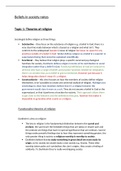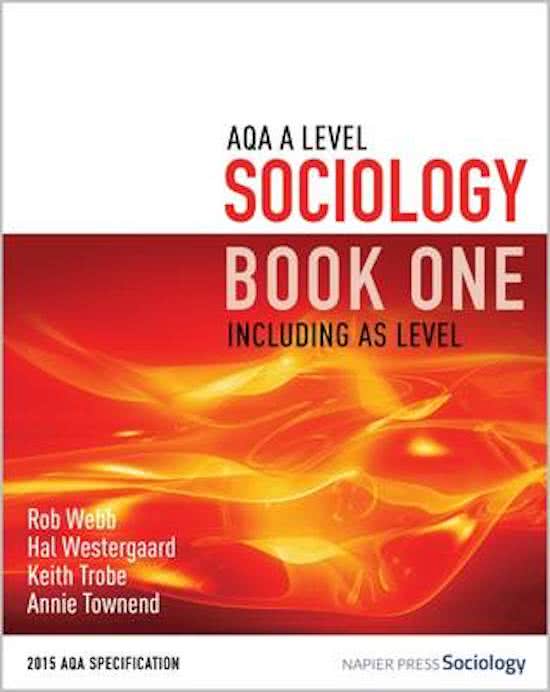Beliefs in society notes
Topic 1: Theories of religion
Sociologist define religion as three things:
Substantive – they focus on the substance of religion e.g. a belief in God, there is a
very clear line made between what is classed as a religion and what isn’t. They
conform to the widespread (western) views of religion but leave no space for any
practices outside of a belief in God. Weber defines religion as a belief in a superior or
supernatural being that cannot be explained scientifically.
Functional – they believe that religion plays a specific social and psychological
functions for society, Durkheim defines religion in terms of its contribution to social
integration rather than a belief in God. Functional definitions of God are inclusive to
all those who have a range of beliefs and practice functions needed for integration,
there’s no western bias as no belief in god is mentioned. However just because it
helps integration doesn’t mean it’s a religion.
Constructionist – this view focuses on how the members of society define religion
themselves, it isn’t possible to create one universal outlook of religion. Aldridge uses
scientology to show how members believe that it’s a religion however the
government would class it more as a cult. They do not assume a belief in God or the
supernatural, or that it performs a function for society. Their approach allows them
to get close to the followers and the definitions they give, however this makes it
impossible to generalise what counts as a religion.
Functionalist theories of religion
Durkheim’s view on religion-
The key to religion is the fundamental distinction between the sacred and
profane, the sacred are the forbidden things that are taboo or inspire awe and
the profane are things that have no special significance that are ordinary. Sacred
things evoke powerful feelings due to how they represent something greater, the
only greater thing is society so religious worship is worship to society.
Durkheim believe that to study something in great detail we must study its
origin, so for society we would study a clan society e.g. Arunta. These tribe
worship totem poles as it symbolises the clan’s origins, they create a feeling of
solidarity. To Durkheim they’re really worshipping society.
, Sacred symbols represent society’s collective conscience which maintains social
integration and brings them all together. Also, to the individual society makes us
feel part of something greater than us.
Worsley (1956) found that many tribes share totems (not sacred to individual
clan), and even if Durkheim is right about Totems it doesn’t prove that he has
found the essence of religion.
Mestrovic (2011) argues that the postmodern society doesn’t apply to
Durkheim’s research, as increasing diversity has fragmented the collective
conscience.
Psychological functions-
Malinowski (1954) argues that religion promotes social solidarity due to its
psychological functions (helping them cope with emotional stress).
2 situations in which religion promotes social solidarity: where the outcome is
important but is uncontrollable and thus uncertain (lagoon fishing is safe but ocean
fishing is dangerous so islanders perform rituals), and at times of life crises (birth,
puberty, marriage, funeral rituals).
Parsons: values and meaning-
Parsons sees religion as a way to help people cope with unforeseen events and
uncontrollable outcomes.
Religion also creates and legitimates society’s central values (Protestantism in the US
sacralised the core American value of individualism) and is the primary source of
meaning (it answers ultimate questions and gives meaning to lives).
Civil religion-
Bellah (2013) saw religion as a way to unify society, especially in such multifaith
societies as the US. A civil religion (a belief system that attaches sacred qualities to
society) unifies over all e.g. ‘the American way of life’.
Functional alternatives are non-religious beliefs that perform functions similar to
those of organised religion, such as reinforcing shared values or maintaining social
cohesion.
Evaluation-
Neglects the negative aspects of religion such as religion being a source for
oppression.
Ignores religion as a source for conflict and division, for example societies with more
than one religion (Civil religions).
Marxist theories of religion
, Religion as an ideology-
Marx believes that religion operates as an ideological weapon used to legitimate
the suffering of the proletariat. Religion misleads the poor into thinking that their
suffering is virtuous and will be rewarded in the afterlife.
Lenin describes religion as ‘spiritual gin’ in how it used an intoxicant to drown out
oppression, creating a ‘mystical fog’ that obscures reality.
Religion also acts a way to legitimate the position of the ruling class, they’re roles are
‘divinely ordained’
Religion and alienation-
Religion acts as an opiate to dull the pain the lower classes feel over alienation
which is the separation they have from the rewards of their hard work. It acts as no
solution, aspects as an afterlife just provides a source of consolation.
Evaluation of Marxism-
Ignores the positive functions of religion such as psychological adjustment to
misfortune. Neo-Marxists see certain forms of religion as assisting not hindering the
development of class consciousness.
Althusser (1971) reject alienation as a scientific concept due to the idea that humans
have an idea of their ‘true self’.
Feminist theories of religion
Evidence of the patriarchy: religious organisations (male dominated despite how
women participate more), places of worship (segregate the sexes, women’s
participation may also be restricted, taboos concerning periods, pregnancy and
childbirth), sacred texts (all feature male figures such as gods of prophets), religious
laws and customs (women are given fewer rights)
Armstrong argued that a lot of earlier religion placed women at the centre e.g.
mother nature or the goddess of fertility, however the development of monotheistic
religions saw the establishment of a single patriarchal figure of god.
Religious forms of feminism-





